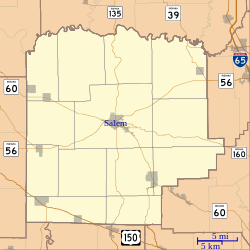First Baptist Church | |
 | |
| Location | 201 N. High St., Salem, Indiana |
|---|---|
| Coordinates | 38°36′25″N86°5′58″W / 38.60694°N 86.09944°W |
| Built | 1900 |
| Architect | Stephans, R.C. |
| Architectural style | Romanesque, Richardsonian Romanesque |
| NRHP reference No. | 85000602 [1] |
| Added to NRHP | March 21, 1985 |
First Baptist Church is a historic Baptist church located at Salem, Washington County, Indiana. It was built in 1900, and is a Richardsonian Romanesque style brick and stone church. It has a central gabled nave and a three-story corner tower with a pyramidal roof. [2]
It was listed on the National Register of Historic Places in 1985. [1] It is also a contributing property in the Salem Downtown Historic District which was NRHP-listed in 1997.




